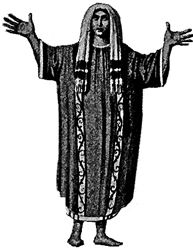Orans Position During A Sit-Down Mass
 Part of the efforts to inculturate the liturgy, we have in this part of the world, many chapels with a very Asian design. This, of course, applies usually if not always, only to small chapels since Asian homes are usually small and the setting is very intimate, in contrast with the large banquet halls the Western culture is more accustomed to.
Part of the efforts to inculturate the liturgy, we have in this part of the world, many chapels with a very Asian design. This, of course, applies usually if not always, only to small chapels since Asian homes are usually small and the setting is very intimate, in contrast with the large banquet halls the Western culture is more accustomed to.Commonly, this kind of design features an altar that is low (but nevertheless in the view of all) and mats instead of pews, so that the priest and the people can just squat on them or on the ground in a reverent position, usually resembling the lotus position for those who are able to sustain this.
Now, some problems can be raised regarding this kind of "sit-down" Mass where the people literally sit through the entire liturgy. In the West, of course, the different postures of standing up, kneeling down, prostrations etc. are expressive of many things according to the different parts of the liturgy where they are used in: reverent listening during the proclamation of the Gospel, profound adoration of the Eucharistic presence at the Elevation (or more appriopriately, showing of the eucharistic species), deep humility before the Crucified Savior on Good Friday etc.
However, we must understand that in the East, the proper sitting position somehow encompasses all these reverential dispositions. A student sits while listening to the instructions of the Master. Even nobles sit while addressing the King. (Although we also have the equivalent prostrations, very elaborate and really beautiful ones in fact, which can actually be explored for liturgical use. Although priests will have to be more physically fit to be able to make these gestures properly and well.) Also, the sitting position vividly expresses the dimension of the Eucharist as a true meal, without diminishing its other and complementary aspect of sacrifice, which demands utmost reverence before the Divine Majesty. Participants in Asian meals all sit down.
Ministers however kneel while ministering. That is why all who perform ministerial duties, even if they are also participants in the meal, should kneel while carrying out their ministerial duties. (Obviously, it is difficult to serve sitting down in this way) This gesture can extend even to the ministry of lectors.
The again there are existential difficulties that arise. People who are not used to this sitting down without a Western "chair" find sustaining this posture this very difficult, even painful. The problem of a presidential chair is even easier to solve by just providing a distinctive mat, stool or pillow. However, special consideration should be made especially for old people, espcially those who are not used to squatting and even for Western faithful who have longer legs and may be present.
In view of this "sit-down" Mass, I would just like to raise here a suggestion regarding the Orans posture, which the Presider makes at many points during the entire liturgy and the people too take during the Lord's Prayer.
There are two current practices. One is to put the palms on top of the knees (facing up or facing down) which is more in conformity with the traditional lotus position. Others however, still raise it in the traditional Western position, palms facing outward and pointing upward. I tend to side with the latter.
The Lord's prayer, at the beginning of the Communion rite, is not primarily a meditative prayer. In contrast, it is a reaching out to the Father of Jesus, begging him for our daily bread-especially that Bread which, not only sustains our earthly life, but also gives us eternal life. Also, it is a reaching out to our brothers and sisters in the gathered assembly, in solidarity as children of the Father and in reconciliation because God himself has forgiven us. That is why in the second part of the Lord's prayer, the petitions are always made in the second person: give us, forgive us, deliver us...
The first practice makes the prayer intimate and very personal, which is also good, but seems incongruent with the liturgical action being carried out in this part of the rite. Moreover, the second practice is closer to the Biblical gesture of the raising of hands in prayer, and also to the posture of Christ, our High Priest, offering himself to the Father on the altar of the Cross.
The same goes not only for the Lord's prayer sung or recited by everybody, but also for the presidential prayers said by the priest alone. On the one hand, his palms face outward to encompass and embrace the prayer of the whole community. At the same time, they point upward to reach out to God, in the manner Christians have prayer with through the ages, and after the manner of the Crucified Christ.


1 Comments:
yeezy
cheap jordans
michael kors outlet online
christian louboutin outlet
cheap nfl jerseys
hermes handbags
air max 90
jordan retro
nike shoes
curry 4
Post a Comment
Subscribe to Post Comments [Atom]
<< Home